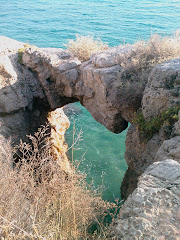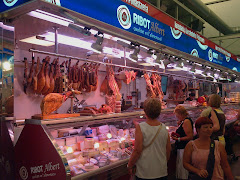

For a country whose history includes large chunks of Muslim occupation it is maybe odd that Pork has become such a definitive national meat. Some have suggested that it is actually a tacit example of Spain’s propensity for rebelling against any who try to force them to be something they don’t want to be. All I know is that Jamon is worshiped here as a national treasure and is treated with a reverence bordering on obsession.
There are two initial distinctions to understand; Serrano and Iberico.
SERRANO
meaning ‘from the mountains’ is made using white ‘Landrace’ pigs. Confusingly it is also known as Jamon Reserva. Jamon Curado, or Jamon Extra. The pigs are compound-fed. The reason they are cured up a mountain is because it’s colder and therefore better for not giving you botulism which is always a good feature!.
Examples of Serrano appellations are:
Cured ham of Trevélez:
cured at least 1,200 meters above sea level. They are qualified to be among the “sweetest” cured hams due to the low degree of salting necessary for the drying and maturing processes to succeed properly. This is caused by the north winds coming from the high tips of Sierra Nevada, which still had copious amounts of snow on it when I was there last May (whilst the city temperature in Granada itself was about 35 C!)
Cured ham of Teruel:
cured at least 800 meters above sea level, with a minimum of a year of curing and aging.
IBERICO
Is made using black Iberian pigs or ‘pata negra’ . It tends to come from the west and south-west of Spain hwere teh cork oak forests border with Portugal. It is classified depending on feed and exercise. The best and most expensive are free range and fed only on acorns (bellota) the next best is fed a mix of commercial feed and acorns, and the least revered is fed only commercial feed and is housed in compounds. The hit parade looks like this:
3. Jamón Ibérico Cebo Campo hogs are compound-fed only commercial feed. Cured 24 months
2. Jamón Ibérico Recebo hogs are raised on commercial feed and fed acorns for the last few months of their lives. Part pasture, part compund fed.
1. Jamón Ibérico Bellota hogs are fed a diet almost exclusively of acorns (bellotas). The are free range and are cured for 36 months. The exercise and diet have a huge impact on the flavour. This is the most prized.
A final varition is a paletilla which is a front leg instead of a back leg. This is less revered, smaller and generally cheaper.
Bellota jamones are prized both for their smooth texture and rich savory taste. A good ibérico ham has regular flecks of intramuscular fat. Because of the pig's diet of acorns, much of the jamón's fat is oleic acid, a monounsaturated fatty acid that has been shown to lower LDL cholesterol and raise HDL cholesterol. (wikepedia)
The fat content is relatively high compared to Jamon Serrano thus giving a richer taste.
Other words you might have seen are Huelva, Jabugo, Guijelo, Salamanca. These are towns which have a DO status and produce particularly good Iberico ham
Of course the hams are not refrigerated. I don’t know how that would go down with the UK health and safety police, but it isn’t a problem here. Every bar has a ham on a stand and many have them hanging from the rafters which is a splendid sight to a glutton like me. Some bars employ sexy staff to entice customers in. I prefer the sight of sexy hams! The curious inverted plastic cones are to catch the drips of fat which form as the ham continues to cure and shrink. Pig fat in your hair tends to drive customers away!













































No comments:
Post a Comment